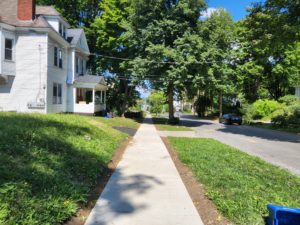Last December (2021), Corey Driscoll Dunham, Chief Operating Officer for the City of Syracuse, spoke to WNA members on Zoom about the city’s new sidewalk maintenance program. It was clear that a decades-long policy of having property owners maintain their sidewalks had failed. Pedestrians were being ill-served in Syracuse. After years of debate a new policy was enacted – the city would fix sidewalks just like they fixed streets (better we hope!), and property owners are now assessed an annual fee. We are now beginning to see this policy and program at work in our neighborhood and around the city.
Inevitably, due to staff and funding limitations, the program will seem uneven. There will be work in some places and nothing elsewhere. Within a few years, however, we should see substantial repairs to the most deteriorated and dangerous sidewalks and the wholesale replacement of others. In the Westcott neighborhood the most dramatic change so far is on the 400 block of Columbus Avenue where recently the entire sidewalk was replaced. Go see it – it is a rare instance where there is an even unbroken continuous concrete sidewalk for an entire block. What a pleasure to walk on!
The 400 block of Columbus (which is also the site of the Gustav Stickley house, where public and private donors have pumped a lot of money into restoring the historic house), has not looked this good in decades. Laid out on the Rosenbloom tract around 1900, the curving street was lined with broken sidewalks – most of which were more than half a century old.
There are some other areas where there is already noticeable change. A little further east there is now continuous sidewalk on East Avenue, connecting East Genesee Street and Salt Spring Road. We’ll try to keep you posted on new work on the Eastside.
Mike Stanton, president of SEUNA summed it up nicely,” Can you imagine trying to accomplish this under the old system, where every property owner would do their own section of sidewalk in their own time-frame, in their own way, using their own contractor? It shows how crazy the old sidewalk system was. Imagine if we treated roads the way we used to manage sidewalks. You would be responsible for the section of roadway in front of your house, even though you don’t own it. Everyone would repave their section of road, when needed, in their own way and time. Why should the pedestrian right of way, and bicycle right of way for that matter, be any less important than that for automobiles?”
We heard again from Corey who is keeping us up-to-date as the program gets going (and it can now be rolled out on smooth pavements!).
She tells us that decisions as “to where sidewalks will be repaired, replaced and/or new sidewalks installed … are driven largely by the same metric that drives the decision-making process for the Supplemental Sidewalk Snow Removal Program – pedestrian safety. Sidewalk installation also has the added complication of where construction is feasible, and although other factors can sometimes come into play, pedestrian safety remains the priority. The planners work closely with the Syracuse Metropolitan Transportation Council (SMTC) to ensure decisions are driven and supported by pedestrian data.”
“With regard to trees, the transportation planners work closely with Forestry in the Parks Department, led by Steve Harris, on the decisions about which trees remain and which need to be removed. Prior to doing any sidewalk work, the Department of Public Works notifies Forestry so they can evaluate what they would like to retain and what to remove, as well as any new tree pits they want to incorporate. DPW’s work obviously can impact street trees, so they work with Forestry to let them know the plans well before the start of any work, and they work closely on the walks that are reinstalled.”
To our mind, there is no rule that state that all sidewalks need to be straight. Where trees are very big, sidewalks can often curve around them. We’ve seen this in many cities, and it has been done even in our neighborhood …see for examples the swerving sidewalk at Dakota and Miles. A curved sidewalk even given some variety and delight for walkers (no time is lost) and save our big, beautiful carbon-storing shade-providing trees.
If you know of a particularly dangerous stretch of sidewalk let us know. If you know a vital tree that might be threatened, speak up!
(SDG)



